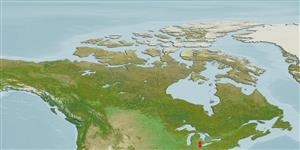Classification / Names
Common names | Synonyms | Catalog of Fishes (gen., sp.) | ITIS | CoL | WoRMS | Cloffa
Actinopterygii (ray-finned fishes) >
Perciformes (Perch-likes) >
Percidae (Perches) > Etheostomatinae
Etymology: Etheostoma: Greek, etheo = to strain + Greek, stoma = mouth; Rafinesque said "various mouths", but Jordan and Evermann suggest the name might have been intended as "Heterostoma (Ref. 45335); spectabile: From the Greek etheo=to strain, and stoma=mouth; spectabile=conspicuous and is appropriate for breeding males (Ref. 79012).
Environment / Climate / Range
Ecology
Freshwater; benthopelagic. Temperate; 4°C - 18°C (Ref. 2059), preferred ?; 43°N - 30°N
North America: Lake Erie and Mississippi River basins from southeastern Michigan and Ohio to eastern Wyoming, and south to Tennessee and northern Texas in the USA; Gulf drainages (Trinity River to San Antonio River) of Texas, mostly on Edwards Plateau.
Size / Weight / Age
Maturity: Lm ? range ? - ? cm
Max length : 7.2 cm TL male/unsexed; (Ref. 5723); common length : 4.7 cm TL male/unsexed; (Ref. 12193)
Inhabit shallow gravel riffles, sometimes rocky runs and pools, of headwaters, creeks and small rivers (Ref. 5723); also found in streams (Ref. 10294). Adults feed on midge and blackfly larvae, mayfly nymphs, isopods, amphipods, and caddisfly larvae (Ref. 10294). Distinct pairing during breeding (Ref. 36980). Eggs are found buried in the substrate (Ref. 7043).
Distinct pairing during breeding (Ref. 36980). Eggs are found buried in the substrate (Ref. 7043).
Page, L.M. and B.M. Burr, 1991. A field guide to freshwater fishes of North America north of Mexico. Houghton Mifflin Company, Boston. 432 p. (Ref. 5723)
IUCN Red List Status (Ref. 115185)
CITES (Ref. 94142)
Not Evaluated
Threat to humans
Harmless
Human uses
Tools
Special reports
Download XML
Internet sources
